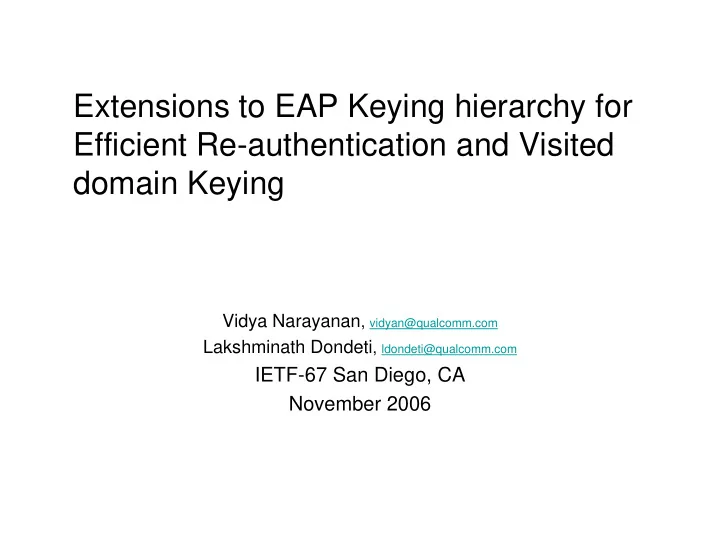

Extensions to EAP Keying hierarchy for Efficient Re-authentication and Visited domain Keying Vidya Narayanan , vidyan@qualcomm.com Lakshminath Dondeti , ldondeti@qualcomm.com IETF-67 San Diego, CA November 2006
Contents • EAP keying hierarchy • Motivation for extending the key hierarchy • Requirements on extending the key hierarchy – Driving applications • Proposed extensions • Summary and next steps 2
EAP keying hierarchy: 802.11i, r Long Term Credential MSK EMSK Figure shows the existing 802.11r PMK-R0 PMK key hierarchy This key hierarchy does not use the EMSK; the second half of the MSK is used to derive the R0-Key TSK … PMK-R1 1 PMK-R1 n This is not a universal model used by other architectures employing 802.11i EAP. … TSK1 TSKn 802.11r 3
Low Latency Re-authentication Requirements • It is unacceptable to have to go back to the home domain upon every handoff in a visited domain – Access to AAAH may be through one or more AAA proxies • A single roundtrip protocol that can result in fresh keying material for new points of attachment is desirable – The protocol must be executable with the visited domain – The resulting key material should be as strong as in the first full authentication case • The protocol must be EAP method independent – Makes executing with the visited domain possible • Method specific operation limited to nodes and their home domain • Ideally, the protocol should be executable in parallel with connection establishment – Security becomes undesirable when any latency or overhead is added to the critical path ☺ 4
EAP Extensions – Constraints • We don’t quite have a free hand in designing EAP extensions – To some extent, we must design around the current designs and usage models of EAP • MSK cannot be used for new keying material – Usage of MSK disparate over different lower layers • EAP authenticators and visited domain entities must not be required to support EAP methods • The key delivery semantics from re-authentication must be similar to MSK delivery – Lower layers must be able to use the key for the same purpose as the MSK (e.g., for TSK derivation) 5
Root key selection • MSK is delivered to the authenticator • MSK is used differently by different lower layers and protocols – IKEv2 uses it for entity authentication – 802 lower layers use it for TSK generation • 802.11i uses the first 16B and 11r uses the rest • 802.16e uses 40B or 20B of the MSK • Conclusion: use the EMSK hierarchy – For lower-layer independence – To avoid changing MSK delivery and usage semantics 6
Solution requirements • Method-independent protocol for efficient re- authentication – Access agnostic; can be used for inter-technology handoffs – Proof of possession of key material of an earlier authentication – Visited-domain EAP-ER capability – Preferably a single roundtrip re-authentication protocol • Key Generation in EAP-ER – EMSK-based hierarchy defined for this purpose • MSK cannot be used for this in an access-agnostic manner – Re-authentication MSKs (rMSK) • Serves the same purpose as an MSK – Visited Domain Keying hierarchy • V-rMSKs derived from this hierarchy for re-authentication in a visited domain 7
Requirements on EAP keying hierarchy • Need a root-key or USRK for EAP-ER – re-authentication Root Key (rRK, derived from EMSK) • A key to prove being a party to the full EAP method- based authentication – This is used in a proof of possession exchange between the peer and the server • A re-authentication Integrity Key (rIK, derived from the rRK) • A new MSK specific to each authenticator that the peer associates with – A re-authentication MSK (rMSK1, rMSK2, …) – Derived from the rRK 8
Re-auth key hierarchy for home domain EMSK … rRK USRK 0 USRK n … rIK rMSK 1 rMSK m TSK 1 TSK m 9
Key derivation • rRK = prf+ (K, S), where, – K = EMSK and – S = rRK Label • (“EAP Re-authentication Root Key”) • rRK_name = NDF-64( EAP Session-ID, rRK Label ) • rIK = prf+ (rRK, "Re-authentication Integrity Key") • rIK_name = prf-64 (rRK, "rIK Name") 10
Visited domain requirements on the EAP keying hierarchy • Need a USRK, visited-domain root key (VRK) for visited domain keying purposes – This is to be maintained at the peer and the home EAP server • Each visited-domain needs a root key to manage domain specific keying requirements – A Visited-domain Master Session Key (VMSK) per domain is derived and delivered by the home EAP server • Each VMSK is held by the visited-domain EAP server and the peer • The rest of the key hierarchy is similar to EMSK hierachy – A V-rRK maps to the rRK – V-rIK maps to the rIK – V-rMSKi maps to rMSKi 11
Visited Domain Re-authentication Key Hierarchy VMSK V-rRK … V-rIK V-rMSK 1 V-rMSK m TSK 1 TSK m 12
13 Example Derivation of VMSK USRK n VMSK m … … EMSK VRK VMSK 1 rRK
VMSK Key derivation • VRK = prf+ (K, S), where – K = EMSK and – S = “EAP Visited domain Root Key” • VRK_name = NDF-64( EAP Session-ID, VRK Label ) • VMSK = prf+ (K, S), where – K = VRK and – S = Server ID || Domain Name • VMSK_name = NDF-64( EAP Session-ID, Server ID || Domain Name ) 14
Summary and Next steps • Two extensions to the EAP keying hierarchy are proposed – Specified derivation of two USRKs • rRK for re-authentication • VRK for Visited-domain keying purposes • From the rRK, a key to prove possession, one or more keys for new authenticators are derived • From the VRK, visited domain MSKs are derived • Specified in – draft-vidya-eap-er-01 – draft-dondeti-eap-vkh-00 • The group is requested to adopt these as WG items 15
Recommend
More recommend